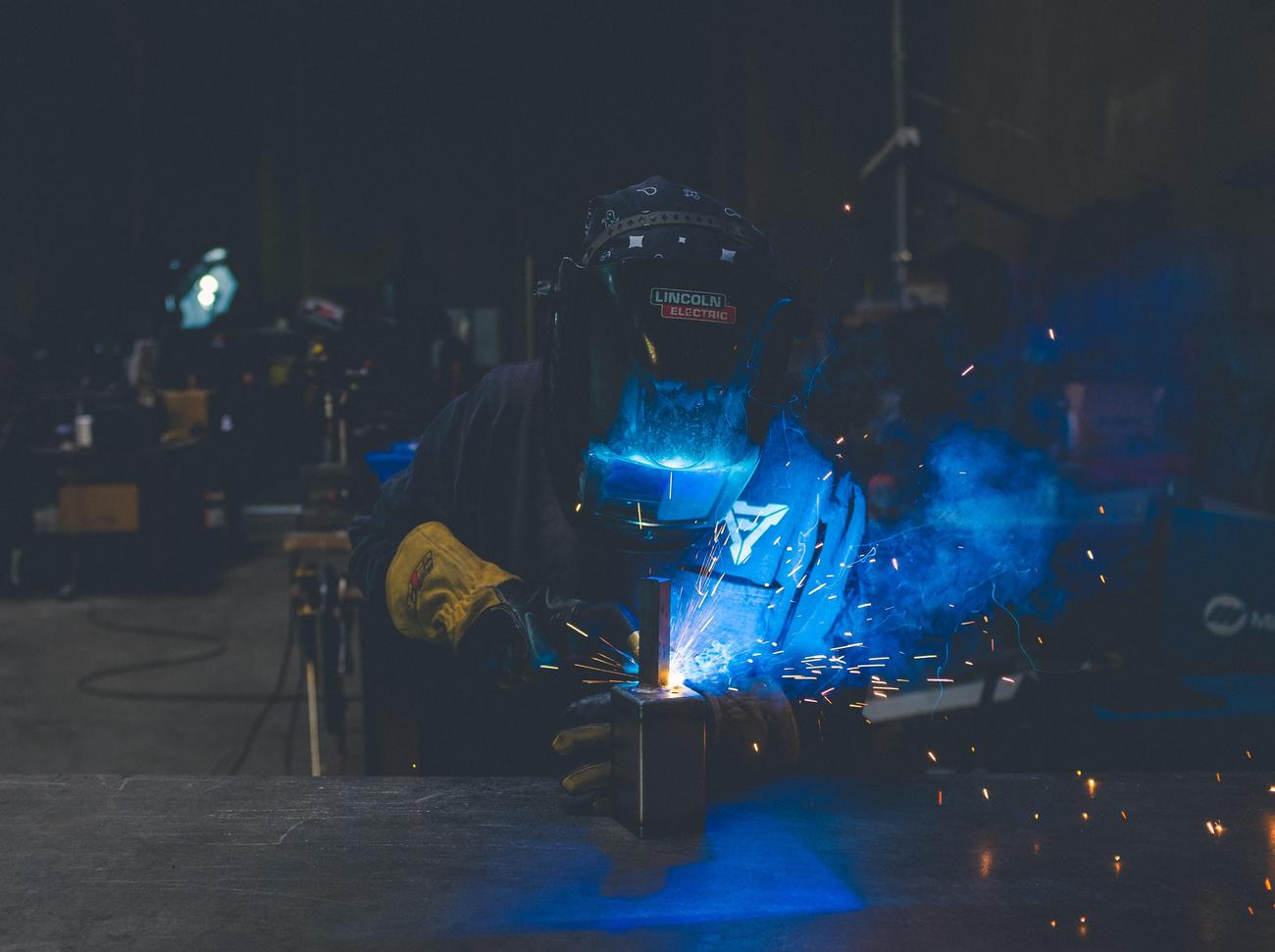Welcome to the fascinating world of steel! In this article, we will dive deep into the steel industry, uncovering 100 intriguing facts about this remarkable material. As an experienced metallurgist and technical writer, I am here to guide you through the intricate details of steel production processes, quality control measures, and the amazing properties of this versatile material. Whether you are a steel enthusiast or simply curious about the importance of steel in various industries, prepare to be engaged as we embark on a comprehensive exploration of the steel industry. So fasten your seatbelts and get ready to be amazed by the incredible world of steel!

100 Facts About Steel
Steel is an incredible material that has shaped the world we live in today. From towering skyscrapers to sturdy bridges, steel is at the heart of modern infrastructure. Let’s delve into the fascinating world of steel and uncover 100 intriguing facts about this versatile metal.
Steel is one of the world’s most innovative and essential materials. Its strength, durability, and versatility make it integral to countless industries and applications.
Steel is infinitely recyclable and exceptionally strong, making it an environmentally sustainable choice. It can be recycled numerous times without losing its properties, reducing the need for new production and conserving resources.
Produced in every region of the world, steel plays a vital role in generating jobs and driving economic growth. The steel industry fosters employment and contributes significantly to local economies.
Global steel production has expanded by 1 billion tonnes since 2000, a testament to its increasing demand and importance in our society.
China is the largest steel producer, manufacturing a staggering 996.3 million tonnes of steel annually. This dominance is a result of China’s rapid industrialization and infrastructure development.
Steel has been used for over 1,000 years, evolving from crude iron production to sophisticated steelmaking processes. Its history is intertwined with the progress of human civilization.
Cold beverage cans are made from steel, showcasing one of the many everyday uses of this remarkable material. Steel cans offer excellent protection and preservation for various beverages.
Daily steel production is astronomically high. The world produces thousands of tonnes of steel every single day, illustrating its indispensability.
The steel industry employs a multitude of people across the globe. From steel mill workers to engineers and researchers, countless individuals contribute to the continuous advancement of this field.
Modern steel is much more efficient than it used to be. Technological advancements have led to the development of high-performance steel alloys that are lighter, stronger, and more resistant to corrosion.
Steel is used in various industries including energy, construction, and automotive. Its reliability and adaptability make it an ideal choice for applications where strength and durability are paramount.
Steel is an alloy of iron and carbon, with the carbon content ranging up to 2 percent. This combination enhances the strength and hardness of the material.
Stainless steels are resistant to corrosion and are commonly used in various applications where protection against rust is critical. From kitchen appliances to surgical instruments, stainless steel is a versatile choice.
Steel framing is strong and stiff, accounting for 25% of steel use in buildings. Its structural integrity supports the construction industry’s quest for safe and durable structures.
Steel played a vital role in World War II. It was extensively used in the production of tanks, weapons, railways, and navies. The superior strength of steel proved instrumental in bolstering military capabilities.
The Eiffel Tower, an iconic symbol of Paris, is primarily constructed from steel. This magnificent structure showcases the engineering prowess and aesthetic appeal of steel.
The demand for steel is projected to continue growing, driven by urbanization, infrastructure development, and technological advancements. Steel will remain a cornerstone of progress in the years to come.
Steel possesses excellent heat conductivity, making it an essential component of cookware and industrial applications that require efficient heat transfer.
Steel can be alloyed with various elements to enhance its properties. For example, adding chromium creates stainless steel, while adding nickel improves its impact resistance.
The automotive industry heavily relies on steel for its superior strength-to-weight ratio, crashworthiness, and cost-effectiveness. From car frames to engine components, steel ensures the safety and performance of vehicles.
Steel is a highly customizable material. Manufacturers can alter its properties through specialized heat treatments and alloying, tailoring it to meet specific requirements.
Steel has excellent formability, allowing it to be shaped and molded into intricate designs. This characteristic makes it a favorite choice for artists and designers.
Steel is essential for renewable energy generation. Wind turbines, solar panels, and hydroelectric plants rely on steel structures to harness and deliver clean energy.
Steel provides an efficient solution for earthquake-resistant construction. Its flexibility and ductility enable buildings to withstand seismic forces, ensuring the safety of occupants.
Steel is a vital component of major infrastructure projects, such as bridges and highways. Its strength and durability ensure the longevity and safety of these critical structures.
Modern steelmaking processes have significantly reduced the carbon footprint of the industry. Innovations in energy efficiency and recycling techniques contribute to a more sustainable steel production.
Steel reinforcement bars, also known as rebars, are extensively used in concrete construction to enhance its tensile strength. This combination creates durable and resilient structures.
Steel’s magnetic properties make it essential for electrical applications, including transformers, generators, and motors. It facilitates the efficient transmission and distribution of electrical power.
The steel industry invests heavily in research and development to innovate new products, improve manufacturing processes, and address environmental concerns. This commitment drives continuous improvement in the field.
Steel is fire-resistant, making it a preferred choice for applications where protection against high temperatures is paramount. From fire-rated doors to fireproof clothing, steel plays a vital role in safeguarding lives and property.
Steel offers exceptional durability, enabling structures to withstand harsh environmental conditions, including extreme temperatures, corrosive chemicals, and severe weather events.
Steel’s strength-to-weight ratio enables the construction of lightweight, yet robust structures. This quality reduces material and transportation costs while maintaining safety and reliability.
Steel’s versatility extends to its various forms. From sheets and bars to tubes and wires, manufacturers produce a range of steel products tailored to diverse requirements.
Steel has a long lifespan, outlasting many other materials. Its resilience ensures structures and products stand the test of time, reducing maintenance and replacement costs.
Steel boasts excellent recycling rates, contributing to a circular economy. Recycled steel can be used in new construction and manufacturing, reducing waste and preserving resources.
Steel is cost-effective in the long run due to its longevity, low maintenance requirements, and recyclability. Its durability translates into substantial savings over the lifetime of a structure or product.
Steel’s malleability allows for efficient fabrication processes. It can be rolled, stamped, and extruded into various shapes, enabling mass production and cost-effective manufacturing.
Steel is a preferred material for high-rise construction. Its strength and load-bearing capabilities ensure the stability and integrity of tall buildings.
Steel can be coated or galvanized to enhance its resistance to corrosion. These protective layers extend the lifespan of steel structures, reducing the need for repairs and replacements.
The steel industry prioritizes safety in all aspects of its operations. Robust safety protocols, employee training, and adherence to regulations contribute to a secure working environment.
Steel is a primary material in the production of appliances, such as refrigerators, washing machines, and stoves. Its durability and clean appearance make it an ideal choice for household use.
Steel’s ductility allows it to absorb energy, making it an excellent material for impact-resistant applications. From car bumpers to bulletproof vests, steel protects against external forces.
Steel is extensively used in the manufacturing of machinery and equipment across various industries. Its reliability and strength ensure the smooth operation and longevity of these capital assets.
Steel is essential in the construction of pipelines for transporting oil, gas, and other fluids. Its resistance to corrosion and structural integrity ensure the safe and efficient transmission of these resources.
Steel supports the development of advanced infrastructure, including smart cities and transportation systems. Its integration with sensors and technologies enables efficient data collection and management.
Steel offers excellent seismic resistance due to its flexibility and ductility. In earthquake-prone regions, steel structures provide enhanced safety for residents and minimize damage to buildings.
Steel is used in the manufacturing of high-speed trains where lightweight yet strong components are crucial for enhancing speed and reducing energy consumption.
Steel’s aesthetic appeal contributes to architectural marvels around the world. Structural steel provides the framework for iconic buildings, allowing for breathtaking designs.
Steel skyscrapers showcase human ingenuity in conquering new heights. These towering structures redefine skylines and exemplify the strength and possibilities of steel.
Steel cables are used in suspension bridges, such as the Golden Gate Bridge in San Francisco and the Akashi Kaikyo Bridge in Japan. These cables bear immense loads and ensure the stability of these monumental structures.
Steel’s ability to conduct electricity makes it essential for power transmission infrastructure, including transmission towers and overhead lines. It facilitates the efficient distribution of electrical energy.
Steel bearings enable smooth movement in machinery and structures, reducing friction and ensuring optimal performance. From car engines to wind turbines, steel bearings support rotational motion.
Steel is used in shipbuilding, providing the necessary strength, toughness, and corrosion resistance required for vessels that navigate the vast oceans.
Steel has played a critical role in space exploration. From rockets and satellites to space station modules, steel components endure the extreme conditions of outer space.
Steel wire ropes support heavy loads in cranes, elevators, and suspension systems. Their strength and durability make them an indispensable choice for lifting and moving operations.
Steel’s anti-corrosive properties make it ideal for water treatment and distribution systems, ensuring the delivery of clean and safe drinking water to communities.
Steel provides a hygienic surface for food processing and storage. Its smooth and easy-to-clean qualities prevent bacterial growth and maintain food quality.
Steel is a key material in the production of storage tanks for various substances, including oil, chemicals, and liquids. Its robustness ensures the containment and safe handling of these materials.
Steel structures are highly resistant to termites and pests, making them an ideal choice for construction in areas prone to infestations.
Steel is magnetic, enabling industrial applications such as magnetic separators that efficiently separate ferrous materials from waste streams.
Steel reinforcement is crucial for underground constructions, such as tunnels and subway systems. It ensures the stability and structural integrity of these hidden infrastructures.
Steel is extensively used in the aerospace industry, where lightweight and high-strength materials are paramount for aircraft design and performance.
Steel’s versatility is evident in its use for furniture and interior design. From elegant chairs to sleek table frames, steel adds a contemporary touch to living and working spaces.
Steel is an excellent material for artistic sculptures and installations. Its ability to be molded into intricate shapes and withstand outdoor exposure makes it a popular choice for artists.
Steel rods are essential components in reinforced concrete structures. Reinforcing bars provide the tensile strength required to withstand bending and tension forces.
Steel’s high melting point allows it to withstand extreme temperatures, making it suitable for applications such as furnaces, ovens, and heat exchangers.
Steel has excellent weldability, allowing for efficient joining of components during manufacturing and construction processes. Welded steel structures exhibit strong and seamless connections.
Steel trusses provide structural support in buildings, bridges, and roof systems. Their lightweight design and load-bearing capabilities contribute to the overall integrity of these structures.
Steel contributes to sustainable transportation. Lighter, fuel-efficient vehicles reduce energy consumption and emissions, promoting a greener future.
Steel is an integral part of the renewable energy industry. From wind turbine towers to solar panel structures, steel supports the growth and viability of clean energy sources.
Steel offers design flexibility for architects and engineers. Its ability to span large distances and withstand various loads allows for creative possibilities in construction.
Steel panels are essential components of prefabricated buildings, providing quick and efficient construction solutions. These structures find applications in disaster relief, remote locations, and temporary housing.
Steel’s high strength and ductility make it an essential material for earthquake-resistant design. In seismic zones, steel-framed buildings offer enhanced safety for occupants.
Steel’s durability and resistance to corrosion make it ideal for outdoor structures such as bridges, stadiums, and pedestrian walkways. It withstands exposure to harsh weather conditions.
Steel contributes to sustainable packaging solutions. Its high strength-to-weight ratio allows for lightweight packaging materials, reducing transportation-related energy consumption and emissions.
Steel is used in the production of durable and long-lasting tools, such as wrenches, hammers, and saws. These tools ensure efficiency and reliability in various industries.
Steel’s magnetic properties make it indispensable in the production of electrical transformers. It enables efficient energy transfer and distribution across power grids.
Steel is an excellent material for fire doors and fire-resistant enclosures. Its ability to withstand high temperatures protects occupants and properties from fire hazards.
Steel contributes to the safety of automotive vehicles through robust crash structures and impact-absorbing systems. It helps protect occupants in the event of accidents.
Steel is the backbone of industrial infrastructure. From factories and warehouses to manufacturing plants, steel provides the structural integrity required for these facilities.
Steel’s reflective properties make it ideal for mirrors and reflective surfaces. Its smooth and shiny surface creates clear and accurate reflections.
Steel contributes to the stability and safety of offshore oil and gas platforms. These structures endure extreme environmental conditions and require materials with exceptional strength and resistance to corrosion.
Steel’s sound-dampening qualities make it suitable for acoustic applications. Its ability to absorb and mitigate sound enables the construction of quiet spaces.
Steel is a material of choice for storage and shelving systems. Its strength and load-bearing capacity allow for efficient organization and storage of goods.
Steel’s non-combustible nature makes it vital for fireproofing materials. Fireproof coatings and systems reinforced with steel protect structures from the spread of fire.
Steel contributes to the efficiency and reliability of electrical grids. Its application in power transmission and distribution infrastructure ensures the smooth flow of electricity.
Steel barriers contribute to road safety by containing and redirecting vehicles during accidents. These barriers minimize the risk of severe collisions and protect roadside structures.
Steel is an integral component of underground mining equipment. Its strength and resistance to impact enable the extraction of minerals and resources from deep within the earth.
Steel is a vital material for industrial machinery, such as cranes and lifts. Its stability and load-bearing capabilities ensure the safe operation of these heavy-duty machines.
Steel contributes to robust and secure fencing systems. From residential boundaries to high-security areas, steel fences offer protection and prevent unauthorized access.
Steel’s thermal conductivity makes it essential for heating and cooling applications, such as radiators and air conditioning systems. It enables efficient heat transfer.
Steel is used in the production of cutting and grinding tools. Its hardness and durability make it indispensable for applications requiring precise and high-performance tooling.
Steel is a key ingredient in the manufacturing of heavy machinery and construction equipment. Its strength and resilience ensure the durability and performance of these machines.
Steel contributes to the safety and reliability of railway infrastructure. From tracks and bridges to locomotives and wagons, steel supports efficient and secure transportation.
Steel is extensively used in the production of agricultural equipment and machinery. Its toughness and versatility enable the cultivation and harvesting of crops at scale.
Steel is vital for the construction of oil and gas storage tanks. These robust structures store valuable resources and ensure their safe containment.
Steel components are essential in the production of medical devices and equipment. From surgical instruments to implants, steel’s biocompatibility and corrosion resistance are crucial.
Steel’s thermal expansion properties contribute to efficient conductive heating systems. From radiators to underfloor heating, steel ensures even heat distribution throughout spaces.
Steel supports the generation of renewable energy through solar panel mounting structures. Its strength and durability allow solar panels to efficiently harvest energy throughout their lifespan.
Steel’s application in the manufacturing of power tools ensures reliability and performance. From drills and saws to grinders and sanders, steel components withstand demanding tasks.
Steel is undoubtedly the foundation of our modern world. From the grandest structures to the smallest instruments, steel’s versatility and reliability make it an indispensable material in countless applications. As we continue to innovate and push the boundaries of what is possible, steel will remain at the forefront, shaping the future of industries and ensuring progress for generations to come.
“Steel is the backbone of progress, supporting our thriving societies and enabling remarkable achievements.”
Steel is an incredible material that has shaped the modern world as we know it. From towering skyscrapers to sturdy bridges, steel is the backbone of our infrastructure. If you’re curious to learn more about the fascinating facts about steel, click here to uncover the secrets that lie within this versatile alloy.
100 Facts About Steel
Steel is a fascinating material that has played a vital role in our lives for centuries. From skyscrapers to bridges, this alloy of iron and carbon has consistently proven its worth. But did you know that steel owes its remarkable properties to the field of metallurgy? If you’re curious to learn more about this intricate relationship between steel and metallurgy, click here: metallurgy.
Steel also holds the key to a sustainable future. With increasing concerns about the environment, finding eco-friendly solutions is paramount. Discover how steel can contribute to a greener tomorrow by clicking here: sustainable future.
In the midst of technological advancements and global challenges, it’s important to stay informed about the materials that shape our world. So dive into the realm of steel, uncover its secrets, and embrace the marvels it has to offer. You won’t be disappointed!
FAQ
Q: How long has steel been used?
A: Steel has been used for over 1,000 years.
Q: Which country is the largest steel producer?
A: China is the largest steel producer, producing 996.3 million tonnes of steel.
Q: What are some industries that use steel?
A: Steel is used in various industries including energy, construction, and automotive.
Q: What is the carbon content in steel?
A: Steel is an alloy of iron and carbon, with the carbon content ranging up to 2 percent.
Q: What are some applications of stainless steel?
A: Stainless steels are resistant to corrosion and are commonly used in various applications.
- Crypto Quotes’ Red Flags: Avoid Costly Mistakes - June 30, 2025
- Unlock Inspirational Crypto Quotes: Future Predictions - June 30, 2025
- Famous Bitcoin Quotes: A Deep Dive into Crypto’s History - June 30, 2025
















